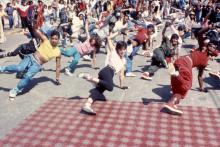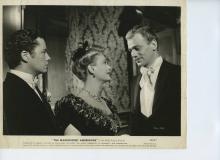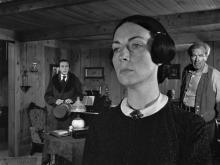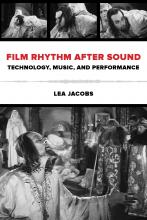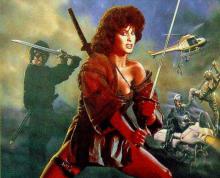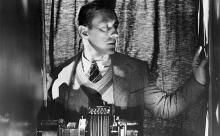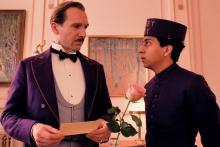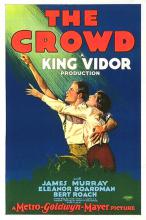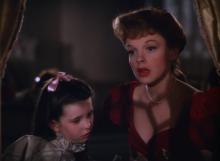This essay on the battle for box-office supremacy between the 1984 breakdancing movies Breakin' and Beat Street, was written by Jenny Oyallon-Koloski, Fellow in Film in the UW Communication Arts Department at UW Madison. A 35mm print of Breakin' will kick off our Marquee Monday: Cannon Fodder series on Monday, February 3, in the Marquee Theater at Union South. The screening will be preceded by 20 minutes of vintage Cannon Films trailers!
By Jenny Oyallon-Koloski
1984 was a busy year for break dancing in the movies. Hollywood studios, afraid that hip hop would be a short-lived phenomenon, attempted to capitalize upon the South Bronx-based artistic movement that was gaining awareness and popularity. “The breakdance tornado approaches,” touts Variety, announcing the May release of Breakin'. The trade journal describes the dance-centered movie as a “surprise break-dancing hit,” but Cannon Films went to extreme measures to ensure its success.
Like the rivalry between the dancing crews of its plot, Breakin’ had to compete for audience attention from Orion Pictures’ Beat Street, another “contemporary new directions musical film” as Variety puts it. Beat Street was certainly lauded as the more prestigious film, with Harry Belafonte as a co-producer, location shooting in New York City (as opposed to the Los-Angeles-based production of Breakin' ), and a world premiere at the Cannes Film Festival. Citing the “hourly” change in youth market musical trends, Beat Street’s producers rushed production of their film to ensure they didn’t miss out on the vogue of the break dancing craze. So they must have been infuriated to learn that Cannon Films was also rushing the release of Breakin’, now scheduled to appear in theaters one month before their film. Beat Street even had to share its Cannes limelight with Breakin’ and two other films that contained references to the popular new dance form, Body Rock and Prison Dancer.
Things went downhill for Beat Street from there. Variety’s review of the film was positive, but their prediction—“success of the recent ‘Breakin’’ bodes well for the b.o. potential of this much larger Harry Belafonte-David V. Picker production”—didn’t quite pan out as expected. Cannon was able to “steal a march on Orion,” says Variety, “whose more expensive breakdance and music pic ‘Beat Street’ opened Friday.” When Beat Street finally hit theaters in June, it received only lukewarm enthusiasm from audiences. In contrast, the Variety reviewer predicted Breakin’s box-office success, given its low cost, light tone, and entertaining breakdancing sequences. Try as they might, Beat Street’s producers couldn’t make up the box office momentum Breakin’ gained from its earlier release.
Breakin’ did well on two additional counts. While the U.S. Catholic Conference deemed most of 1984’s film content “morally offensive” or for “adults only,” as Variety reports, Cannon producers could rest easy knowing that Breakin’ was one of the few films of the year deemed appropriate for adults and adolescents. Cannon Films also wasted no time putting a sequel into production. Variety ads for Breakin’ 2: Electric Boogaloo appeared only a month after the initial film’s release, with Cannon modestly heralding the new film as “The Making of the 7th Major” (despite the superior title, Breakin’ 2 did not live up to the widespread success of its predecessor, though it does get a shout-out in Gilmore Girls [S2 E12] as a contender in “the worst film festival ever”).
The competition for audiences between Breakin’ and Beat Street was more balanced in album sales. The importance of selling pop soundtracks and singles alongside their cinematic counterparts was an important marketing strategy for both films. Mutual interest existed between Hollywood and record companies to produce films with “pop-oriented soundtracks” that could help sell the albums and vice versa, with Flashdance (1983) and Footloose (1984) as recent, successful models. Variety suggests Breakin’s album was a hit for Polygram Records, with the soundtrack “shaping up as the diskery’s biggest soundtrack LP since ‘Flashdance.’” Atlantic Records used a cluster release strategy for Beat Street’s singles, a relatively new way of selling records and building hype for the movie right before it hit theaters by flooding the radio waves with multiple singles. Based on this model, used successfully for the wildly popular Footloose and its soundtrack album, Atlantic had four of Beat Street’s singles in circulation while the film was in release. A loftier goal, per Variety, was the hope that the album would “help hip-hop to make the transition from an urban phenomenon to a more widely accepted form of mainstream entertainment,” with some help from a promotional video on hip-hop culture narrated by co-producer Harry Belafonte.
Beyond their cinematic rivalries, Breakin’ and its break dancing cinematic counterparts seem to have had some unexpected effects on dance culture in cities beyond New York. In July, when both Breakin’ and Beat Street were battling it out at the box office, city councilors in Boston were considering enacting an ordinance against public exhibitions, given the rise of breakers performing in the streets. In addition to the complaints about inconveniences to pedestrians, Variety reports, city officials expressed concerns over potential “lawsuits against the city if the dancers trip over the parking meters.” So much for the short-lived nature of break dancing that Hollywood anticipated.

